Education Links
Leaving Cert
 Maths
Maths
 French
French
 English
English
 Chemistry
Chemistry
 Physics
Physics
 Biology
Biology
 Economics
Economics
 Spanish
Spanish
 Geography
Geography
 History
History
Junior Cert
The rate of decay (activity) of a radioactive nuclide is directly proportional to the number of undecayed nuclei present in the sample.
1. Definition of Refraction
The change in direction of travel of waves when they go from one medium to another because their speed changes as they go from one medium to another.When waves go from one medium to another they speed up or slow down. The bigger the change in speed the bigger the change in direction. The waves are said to be bent or refracted.
2. The Laws of Refraction
Law 1: The incident wave, the refracted wave and the normal at the point of incidence all lie in the same plane.Law 2 (Snell's Law): The ratio of the sine of the angle of incidence to the sine of the angle of refraction is a constant for a given pair of media.
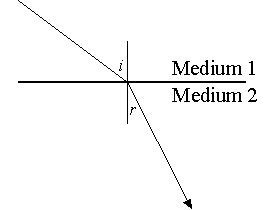
Notes:
(i) You should remember the mathematical equation exactly as given as one version will always solve the problem set on Snell's Law.
(ii) The Law holds for all waves.
(iii) i = angle of incidence, r = angle of refraction.
1n2 = the refractive index from medium 1 to medium 2 and is only given for light waves.
l1 = the wavelength of waves in medium 1
l2 = the wavelength of waves in medium 2
It is clear from Snell's Law that as waves travel from one medium to another their direction changes (i to r), their speed changes (
3. Refractive Indices
(a) Definition: The refractive index (RI) of a medium is defined as the ratio of the speed of light in air to the speed of light in the medium.RI of a medium = ![]() =
= ![]()
(b) Notes
(i) Strictly speaking, a vacuum should be used instead of air. However, for practical reasons refractive indices are always quoted with respect to air.
(ii) Table of Refractive Indices.
| Medium | RI |
| Air | 1 |
| Glass | 1.5 |
| Water | 1.3 |
| Diamond | 2.4 |
The refractive index of glass is 1.5. This means that the speed of light in glass is two-thirds the speed of light in air.
(c) Tricks
Trick 1:

Trick 2:

4. Tricks with Snell's Law
(i) If the refractive index of medium 1 is smaller than that of medium 2 then the speed of light in medium 1 is bigger than that in medium 2. This means that when light goes from one medium to another light slows down if the refractive index increases. This is because:(ii) If light travels from one medium to another with an increase in refractive index then the light is bent towards the normal and vice-versa. This is because:
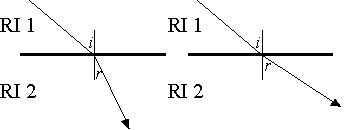
RI 2 > RI 1
(iii) If a wave slows down in going from one medium to another it is bent towards the normal. If it speeds up it is bent away from the normal. This is because:

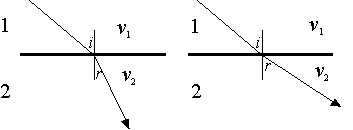
(iv) If a ray of light is incident on a prism parallel to the base as shown it always emerges refracted towards the base.
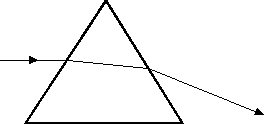
5. Problems on Snell's Law
Example 1
Light is incident from air to glass at 30o. Find the angle of refraction.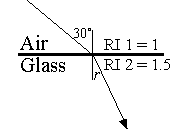
Example 2
Light is incident from water to air at 10o. Find the angle of refraction. (RI of water = 1.3).
Example 3
Light is incident from water to glass at 15o. Find the angle of refraction. (RI of water = 1.3, RI of glass = 1.5).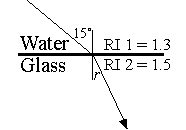
Example 4
Sound waves are incident from water to air at 30o. Find the angle of refraction.
Solution
Example 5
Waves are incident from medium 1 to medium 2 at 12o. Find the angle of refraction if the wavelength of the waves in medium 2 is four times the wavelength in medium 1.
Solution
Example 6
Light is incident from air to a medium at 30o. If the angle of refraction is 20o find the refractive index of the medium.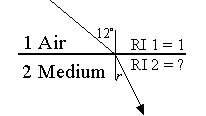
Solution


